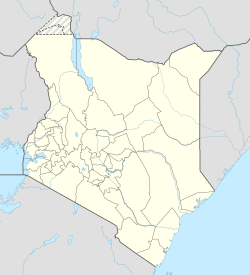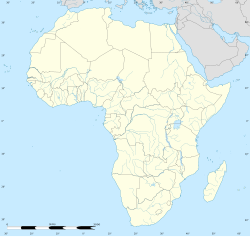Kilifi
Kilifi | |
|---|---|
 | |
| Coordinates: 3°38′S 39°51′E / 3.633°S 39.850°E | |
| Country | |
| County | Kilifi County |
| Population (2009) | |
• Total | 122,899[1] |
| Time zone | UTC+3 (EAT) |
Kilifi is a town on the coast of Kenya, 56 kilometres (35 mi) northeast of Mombasa by road. The town lies on the Kilifi Creek and sits on the estuary of the Goshi River.[2] Kilifi is the capital of Kilifi County and had a population of 122,899 during the 2009 census.[1]
Kilifi is known for its sandy beaches and for the ruins of Mnarani, including mosques and tombs, dating from the 14th to the 17th century.[citation needed]
Geography and climate
[edit]Kilifi town sits on both sides of the estuary and is linked by the Kilifi Bridge which overlooks the estuary.[2] The south side has the Mnarani ruins and Shauri Moyo beach while the north side is the main part of Kilifi Town and Bofa Beach.
The weather is generally warm throughout the year (above 25 °C) with two seasons of moderate rainfall (about 800–1000 mm). Long periods of rain start around March and last into July, while the short periods start around October and last until December.
The terrain is generally flat with sandy-loamy soils with the common trees being Cocos nucifera, Anacadium occidentale, Azadirachta indica, and Mangifera indica.
Demographics
[edit]Kilifi is a cosmopolitan town with mixed ethnic groups. The predominant inhabitants (about 80%) are from the Mijikenda groups (mainly Giriama and Chonyi).[3] Other groups include the Swahili-Arab descendants, Barawas, Bajunis, Somalis as well as other groups from inland. There is a handful of Indians, and Europeans, mainly British, German and Italian.
Economy
[edit]
Like every coastal town, fishing in Kilifi is one of the historical economic activities. With time, the town has slowly been transforming from a fishing village to basic industrial and service.
The growth of the town was mainly fuelled by the cashew nut milling factory between 1976 and 1990; the district has been a producer of cashews since 1930.[4] The town almost became a ghost town when the factory was closed in 1990 due to a decline in nuts supply, mismanagement of the factory and increased global competition.[5] Other industrial activities include sisal farming at Kilifi Plantations.
Since 2008 with the transformation of the Kilifi Institute of Agriculture into Pwani University there has been substantial expansion of the service sector as a result of this. Banking activity has been growing with about 7 banks (KCB, Barclays, Postbank, Imperial, Equity, Cooperative, Diamond Trust Bank and most recently National Bank) as well as microfinance institutions. Retail businesses and hotels have historically been significant economic activities.
Tourism
[edit]Tourism is an important economic activity in Kilifi, supported by its beaches, historical sites, and cultural heritage. Kilifi has a coastline with several kilometers of sandy beaches, including Bofa Beach, which is noted for its clear waters and white sands. The area offers a less commercialized alternative compared to nearby destinations such as Malindi and Watamu.
Historical landmarks, such as the Mnarani Ruins from the 14th century, contribute to Kilifi's appeal, providing insight into the region's Swahili history. Cultural festivals in Kilifi also highlight the traditions of the local Mijikenda communities, drawing visitors from both within Kenya and abroad.
Tourism in Kilifi contributes to local employment and supports businesses such as hotels, restaurants, and tour operators. Sustainable tourism initiatives are being promoted to preserve the area's natural and cultural resources.
Health
[edit]The Kilifi County Hospital, which is also a referral hospital, serves all of Kilifi County and also supports the KEMRI-Wellcome Trust Research Programme,[6] a large medical research centre collaborative between Kenya's KEMRI and the British Wellcome Trust, known for its work on malaria and bacterial and viral childhood infections. Several other private clinics can be found here. The Khairat Medical Centre which was recently opened is equipped with a modern laboratory, x-ray, and scan machines with qualified personnel and is situated in the Mtaani area of Sokoni Sub-Location opposite Masjid Hudaa. Mephi Hospital is also a registered and certified level 4 hospital situated in Mephi Plaza, Prison Road off Mombasa - Malindi highway, offering intensive medical services including dialysis, minor surgeries and radiological services.
Notable organizations
[edit]Kilifi is home to several notable organizations, including:
- Salty's Kitesurf Village - A boutique hotel with an IKO-certified kitesurfing training centre and a beach bar
- Pwani University: A university with undergraduate and graduate programs, specializing in Coastal, Marine and Fisheries science, in addition to Agriculture and Microbial Science[7]
- KEMRI-Wellcome Trust: A 25+ year partnership between KEMRI and Wellcome Trust, doing medical research next to the Kilifi District Hospital (http://www.kemri-wellcome.org/)
- Moving the Goalposts: A nonprofit organization founded in 2002, using football as a tool to empower girls and young women
- KOMAZA: A social business growing trees with smallholder farmers for sale as sustainable wood products
- Grassroots Economics: Grassroots Economics is a non-profit foundation that has been seeking to empower marginalized communities to take charge of their own livelihoods and economic future since 2010. https://www.grassrootseconomics.org/
- World Vision
- Plan International
- Distant Relatives: A popular eco-lodge & restaurant
- Beneath the Baobabs, which hosts one of Kenya's largest New Year's Eve parties
- The Twisted Fig Restaurant
- K.E.D.A (Kilifi Education and Development Association)[citation needed]
- The Fred Hollows Foundation
See also
[edit]References
[edit]- ^ a b "2009 Census Vol 1 Table 3 Rural and Urban Population | Open Data Portal". Archived from the original on 2016-07-29. Retrieved 2016-07-28.
- ^ a b Weiss, Robert; Bahlburg, Heinrich (2006). "The Coast of Kenya Field Survey after the December 2004 Indian Ocean Tsunami". Earthquake Spectra. 22 (S3): S235 – S240. doi:10.1193/1.2201970. S2CID 110486072.[permanent dead link]
- ^ Wekesa, E.; Mwangi, W.; Verkuijl, H. Adoption of Maize Production Technologies in the Coastal Lowlands of Kenya. CIMMYT. p. 6. ISBN 978-970-648-099-6.
- ^ Kenya National Assembly Official Record (Hansard). 5 July 2006. p. 11.
- ^ "Kenya: How Brokers Drove Cashew Nut Farmers into Poverty". 19 May 2021.
- ^ "KEMRI Wellcome Trust". KEMRI Wellcome Trust. 8 August 2013. Retrieved 9 December 2013.
- ^ "Pwani University". Pwani University. Retrieved 2023-05-15.


